Kingdom Animalia Class Mammalia Family Camelidae | Phylum Chordata Order Artiodactyla Genus Camelus Height Dromedary: 1.8 – 2 m | |
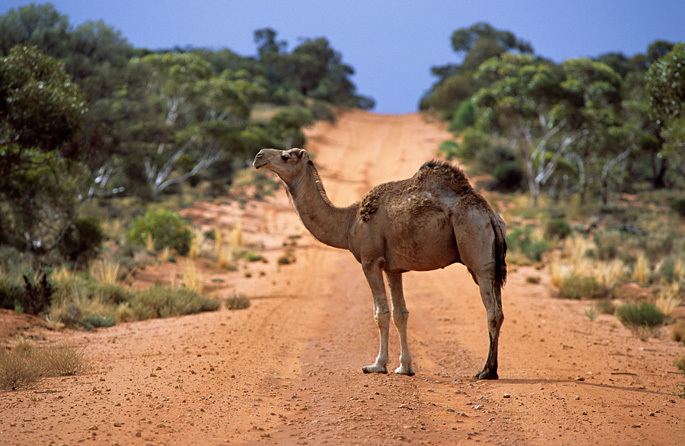 | ||
Mass Dromedary: 400 – 600 kg, Bactrian camel: 480 kg Gestation period Dromedary: 15 months, Bactrian camel: 13 months Representative species Dromedary, Bactrian camel | ||
Australian feral camel management project 2013
Australian feral camels are feral populations consisting of two species of camel: mostly dromedaries (Camelus dromedarius) but also some bactrian camels (Camelus bactrianus). Imported into Australia from British India and Afghanistan during the 19th century for transport and construction during the colonisation of the central and western parts of Australia, many were released into the wild after motorised transport replaced the use of camels in the early 20th century, resulting in a fast-growing feral population.
Contents
- Australian feral camel management project 2013
- History
- Muslim cameleers
- Impact on Aboriginal people
- Feral Population
- Impact on the environment
- Effect on infrastructure
- Management project
- Camel industry
- References

By 2008, it was feared that Central Australia's feral camel population had grown to about one million and was projected to double every 8 to 10 years. Camels are known to cause serious degradation of local environmental and cultural sites particularly during dry conditions. A $19 million(Australian Dollars) management program was funded in 2009 and upon completion in 2013, the feral population was estimated to have been reduced to around 300,000.

History
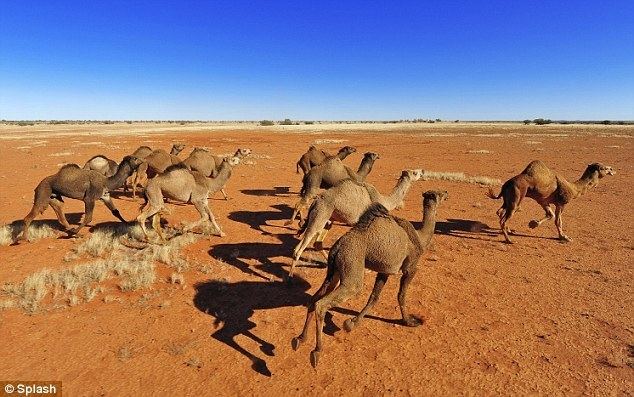
Camels had been used successfully in desert exploration in other parts of the world. The first suggestion of importing camels into Australia was made in 1822 by Danish-French geographer and journalist Conrad Malte-Brun, whose Universal Geography contains the following;
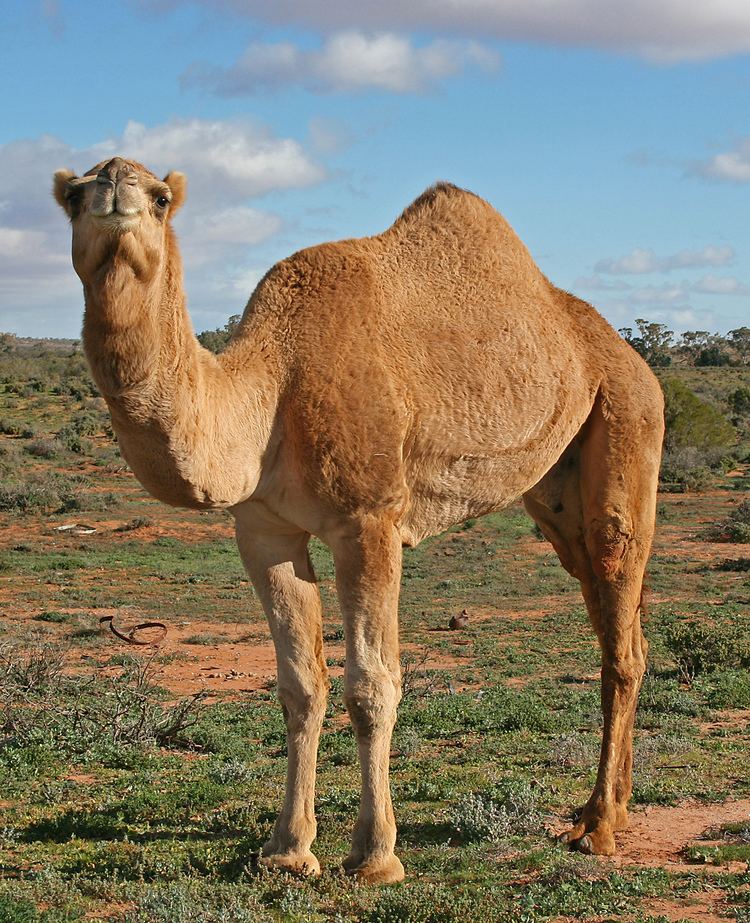
For such an expedition, men of science and courage ought to be selected. They ought to be provided with all sorts of implements and stores, and with different animals, from the powers and instincts of which they may derive assistance. They should have oxen from Buenos Aires, or from the English settlements, mules from Senegal, and dromedaries from Africa or Arabia. The oxen would traverse the woods and the thickets; the mules would walk securely among rugged rocks and hilly countries; the dromedaries would cross the sandy deserts. Thus the expedition would be prepared for any kind of territory that the interior might present. Dogs also should be taken to raise game, and to discover springs of water; and it has even been proposed to take pigs, for the sake of finding out esculent roots in the soil. When no kangaroos and game are to be found the party would subsist on the flesh of their own flocks. They should be provided with a balloon for spying at a distance any serious obstacle to their progress in particular directions, and for extending the range of observations which the eye would take of such level lands as are too wide to allow any heights beyond them to come within the compass of their view.
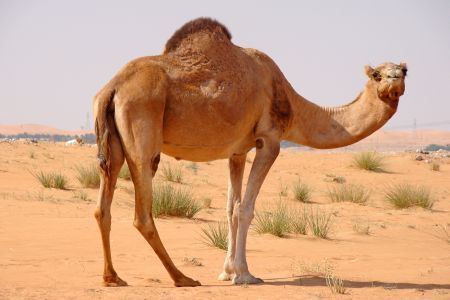
In 1839, Lieutenant-Colonel George Gawler, second Governor of South Australia, suggested that camels should be imported to work in the semi-arid regions of Australia.
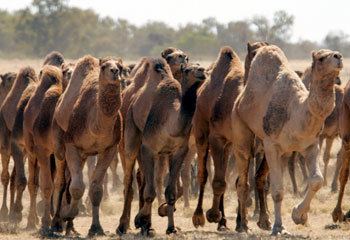
The first camel arrived in Australia in 1840, ordered from the Canary Islands by the Phillips brothers of Adelaide (Henry Weston Phillips (1818-1898); George Phillips (1820-1900); G M Phillips (unknown)). The Apolline, under Captain William Deane, docked at Port Adelaide in South Australia on 12 October 1840, but all but one of the camels died on the voyage. The surviving camel was named Harry.
This camel, Harry, was used for inland exploration by pastoralist and explorer John Ainsworth Horrocks on his ill-fated 1846 expedition into the arid South Australian interior near Lake Torrens, in searching for new agricultural land. He became known as the 'man who was shot by his own camel'. On 1 September Horrocks was preparing to shoot a bird on the shores of Lake Dutton. His kneeling camel moved while Horrocks was reloading his gun, fatally injuring Horrocks by injuring the middle fingers of his right hand and a row of teeth. Horrocks died of his wounds on 23 September in Penwortham after requesting that the camel was shot.
Muslim cameleers
Australia's first major inland expedition to use camels as a main form of transport was the Burke and Wills expedition in 1860. The Victorian Government imported 24 camels for the expedition. The first Muslim cameleers arrived on 9 June 1860 at Port Melbourne from Kurrachee on the ship the Chinsurah, to participate in the Burke and Wills expedition. As described by the Victorian Exploration Expedition Committee, "the camels would be comparatively useless unless accompanied by their native drivers". The cameleers on the expedition included 45-year-old Dost Mahomed, who was bitten by a bull camel losing permanent use of his right arm, and Esa (Hassam) Khan from Kalat, who fell ill near Swan Hill. They cared for the camels, loaded and unloaded equipment and provisions and located water on the expedition.
From the 1860s onward small groups of cameleers were shipped in and out of Australia at three-year intervals, to service South Australia's inland pastoral industry. Carting goods and transporting wool bales by camel was a lucrative livelihood for them. As their knowledge of the Australian outback and economy increased, Muslim cameleers began their own businesses, importing and running camel trains. By 1890 the camel business was dominated by Muslim merchants and brokers, commonly referred to as "Afghans" or "Ghans", despite their origin often being British India (now Pakistan) as well as Afghanistan. They belonged to four main groups: Pashtan, Baluchi, Punjabi, and Sindhi. At least 15,000 camels with their handlers are estimated to have come to Australia between 1870 and 1900. Most of these camels were dromedaries, especially from India, including the Bikaneri war camel from Rajasthan as a riding camel, and lowland Indian camels for heavy work. Other dromedaries included the Bishari riding camel of North Africa and Arabia. A bull camel could be expected to carry up to 600 kilograms (1,300 lb), and camel strings could cover more than 25 miles per day.
Camel studs were set up in 1866, by Sir Thomas Elder and Samuel Stuckey, at Beltana and Umberatana Stations in South Australia. There was also a government stud camel farm at Londonderry, near Coolgardie in Western Australia, established in 1894. These studs operated for about 50 years and provided high-class breeders for the Australian camel trade.
Camels continued to be used for inland exploration by Peter Warburton in 1873, William Christie Gosse in 1873, Ernest Giles in 1875–76, David Lindsay (explorer) in 1885–1886, Thomas Elder in 18911892, on the Calvert Expedition in 1896–97, and by Cecil Madigan in 1939. They were also used in the construction of the Overland Telegraph Line, and carried pipe sections for the Goldfields Water Supply Scheme.
The introduction of the Immigration Restriction Act 1901 and the White Australia policy made it more difficult for cameleers to enter Australia.
Impact on Aboriginal people
Some Aboriginal people can still recall their first sightings of camels. Pitjantjatjara man Andy Tjilari describes camping with his family as a child, when a man traveling with camels arrived in search of dingo scalps. When the initial shock wore off, Mr Tjilari describes following the camels with his family, mimicking them and talking to them. The discovery led him to assert that "this horse is ignorant".
As Muslim cameleers increasingly travelled through the inland they encountered a diversity of Aboriginal groups. An exchange of skills, knowledge and goods soon developed. Some cameleers assisted Aboriginal people by carrying traditional exchange goods, including red ochre or the narcotic plant pituri, along ancient trade routes such as the Birdsville Track. The cameleers also brought new commodities such as sugar, tea, tobacco, clothing and metal tools to remote Aboriginal groups. Aboriginal people incorporated camel hair into their traditional string artefacts, and provided information on desert waters and plant resources. Some cameleers employed Aboriginal men and women to assist them on their long desert treks. This resulted in some enduring partnerships, and several marriages.
From 1928 to 1933, the missionary Ernest Kramer undertook camel safaris in Central Australia with the aim of spreading the gospel. On most journeys, he employed Arrernte man Mickey Dow Dow as cameleer, guide and translator and sometimes a man called Barney. The first of Kramer’s trips was to the Musgrave Ranges and Mann Ranges, and was sponsored by the Aborigines Friends Association, which sought a report on Indigenous living conditions. According to Kramer’s biography, as the men travelled through the desert and encountered local people, they handed them boiled lollies, tea and sugar and played Jesus Loves Me on the gramophone. At night, using a ‘magic lantern projector’, Kramer showed slides of Christmas and the life of Christ. For many people, this was their first experience of Christmas and the event picturesquely established "an association between camels, gifts and Christianity that was not merely symbolic but had material reality".
By the 1930s, as the cameleers became displaced by motor transport, an opportunity arose for Aboriginal people. They learnt camel-handling skills and acquired their own animals, extending their mobility and independence in a rapidly changing frontier society.
Camels still regularly appear as a motif in Indigenous Australian art.
Feral Population
With the introduction of motorised transportation in the 1920s and 1930s, some cameleers released their camels into the wild. Well suited to the arid conditions of Central Australia, these camels became the source for the large population of feral camels still existing today.
Australia is the only country with feral herds of camels, the largest population in the world. It has the only herd of dromedary (one-humped) camels exhibiting wild behaviour in the world. (Other feral dromedary populations existed in the 20th century in Doñana National Park in Spain, and in the southwestern United States, while a small population of wild Bactrian camels still exists in the Gobi Desert.)
The exact population of Australian feral camels is not known. In 2008 the number of feral camels was estimated to be more than one million, with the capability of doubling in number every 8 to 10 years. In 2013, this estimate was revised to a population of 600,000 prior to culling operations, and around 300,000 camels after culling, and increasing 10% per year.
Impact on the environment
Although their impact on the environment is not as severe as some other pests introduced in Australia, camels ingest more than 80% of the plant species available. Degradation of the environment occurs when densities exceed two animals per square kilometre, which is presently the case throughout much of their range in the Northern Territory where they are confined to two main regions: the Simpson Desert and the western desert area of the Central Ranges, Great Sandy Desert and Tanami Desert. Some traditional food plants harvested by Aboriginal people in these areas are seriously affected by camel-browsing. While having soft-padded feet makes soil erosion less likely, they do destabilise dune crests, which can contribute to erosion. Feral camels do have a noticeable impact on salt lake ecosystems, and have been found to foul waterholes.
Effect on infrastructure
Camels can do significant damage to infrastructure such as taps, pumps and even toilets as a means to obtain water, particularly in times of severe drought. They also damage stock fences and cattle watering points. These effects are felt particularly in Aboriginal and other remote communities where the costs of repairs are prohibitive.
Drought conditions in Australia during the first decade of the 21st century (the "Millennium drought") were particularly harsh, leading to thousands of camels dying of thirst in the outback. The problem of invading camels searching for water became great enough for the Australian authorities to plan to eradicate as many as 6,000 camels that had become a nuisance in the community of Docker River, where the camels were causing severe damage in their search for food and water. The planned cull was reported internationally and drew a strong reaction.
Management project
The Australian Feral Camel Management Project was established in 2009. It was managed by Ninti One Limited in Alice Springs funded with A$19 million from the Australian Government. It aimed to work with landholders to build their capacity to manage feral camels while reducing impacts at key environmental and cultural sites. The project was expected to be completed by June 2013 but received a six-month extension. It was completed A$4 million under budget.
It was a collaboration between nineteen key partners: the Governments of Australia, Western Australia, South Australia, Northern Territory and Queensland; Central Land Council, Anangu Pitjantjatjara Yankunytjatjara Lands, Ngaanyatjarra Council Inc., Kanyirninpa Jukurrpa, Pila Nguru Aboriginal Corporation, Kimberley Land Council and Western Desert Lands Aboriginal Corporation; South Australian Arid Lands NRM, Alinytjara Wilurara NRM Board, Natural Resource Management Board NT Inc. and Rangelands NRM WA; Northern Territory Cattlemen’s Association; Australian Camel Industry Association; RSPCA; Australian Wildlife Conservancy; CSIRO; and Flinders University.
In November 2010 the Australian Government Department of Environment released the National Feral Camel Action Plan, a national management plan for what it defined an 'Established Pest of National Significance' in accordance with its Australian Pest Animal Strategy.
Ninti One and its partners gained their consent over 1.3 million square kilometres of land, mapping culling zones. About 40 per cent of the camel population is thought to be on Aboriginal land. A range of techniques were used to consult with Traditional Owners including using jerry cans to demonstrate the amount of water a camel can drink. Rice was scattered over maps to demonstrate the number of camels in certain areas and the projected population growth. Different groups have different associations with camels - in some areas they are even seen as biblical animals. Landholders chose to allow a range of removal techniques on their land. Some regions like Ngaanyatjarra Lands and Anangu Pitjantjatjara Yankunytjatjara Lands are opposed to aerial culling, using mustering and water points to control the animals instead. The Central Land Council undertook mustering programs with Indigenous ranger groups as well.
At the completion of the project in 2013, the Australian Feral Camel Management Project had reduced the feral camel population by 160,000 camels. This includes over 130,000 through aerial culling, 15,000 mustered and 12,000 ground-culled (shot from vehicle) for pet meat. It estimated around 300,000 camels remained, the population increasing 10% per year. The largest individual aerial cull operation was conducted in mid-2012 in the south-west of the Northern Territory. It employed three R44 helicopter cull platforms in combination with two R22 helicopter spotting/mustering platforms. It removed 11,560 feral camels in 280 operational hours over 12 days, over 45,000 square kilometres, at a cost of around $30 per head.
The project faced criticism from some parts of the Australian camel industry, who wanted to see the feral population harvested for meat processing, the pet-meat market, or live export, arguing it would reduce waste and create jobs. Poor animal condition, high cost of freight, the lack of infrastructure in remote locations, and difficulty in gaining the necessary permissions on Aboriginal land are some of the challenges faced by the camel industry.
No ongoing funding has been committed to the program. Ninti One estimates that A$4 million per year is required to maintain current population levels.
Camel industry
A multi-species abattoir at Caboolture in Queensland run by Meramist regularly processes feral camels, selling meat into Europe, the United States and Japan. Samex Australian Meat Company in Peterborough, South Australia, also resumed processing feral camels in 2012. It is regularly supplied by an Indigenous camel company run by Ngaanyatjarra Council on the Ngaanyatjarra Lands in Western Australia and by camels mustered on the Anangu Pitjantjatjara Yankunytjatjara Lands of South Australia. A small abattoir on Bond Springs Station just north of Alice Springs also processes small quantities of camels when operational.
Camel meat was also used in the production of pet food in Australia. In 2011, the RSPCA issued a warning after a study found cases of severe and sometimes fatal liver disease in dogs that had eaten camel meat containing the amino acid indospicine, present within some species of a genus of plants known as Indigofera.
There are operating camel farms at Kings Creek Station near Uluru, Calamunnda Camel Farm in Western Australia, Camels Australia at Stuart Well south of Alice Springs and Pyndan Camel Tracks in Alice Springs.
Australia’s first commercial scale camel dairy, Australian Wild Camel Corporation, was established in 2015 in Clarendon, Queensland. There are also several small-scale camel dairies: QCamel in Central Queensland, in New South Wales' Upper Hunter District, Camel Milk Australia in South Burnett, Queensland, and Australian Camel Dairies near Perth in Western Australia.
Live camels are occasionally exported to Saudi Arabia, the United Arab Emirates, Brunei, and Malaysia, where disease-free wild camels are prized as a delicacy. Australia's camels are also exported as breeding stock for Arab camel racing stables, and for use in tourist venues in places such as the United States. Exports to Saudi Arabia where camel meat is consumed began in 2002.
There are also two popular camel racing events in Central Australia, the Camel Cup in Alice Springs and the Uluru Camel Cup at Uluru Camel Tours at Uluru.
